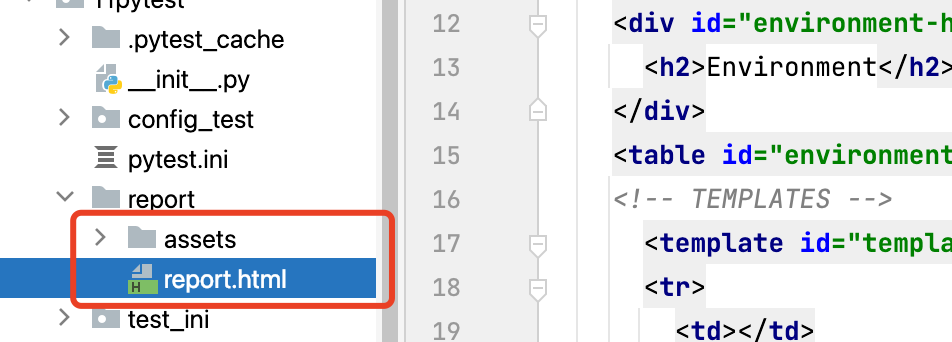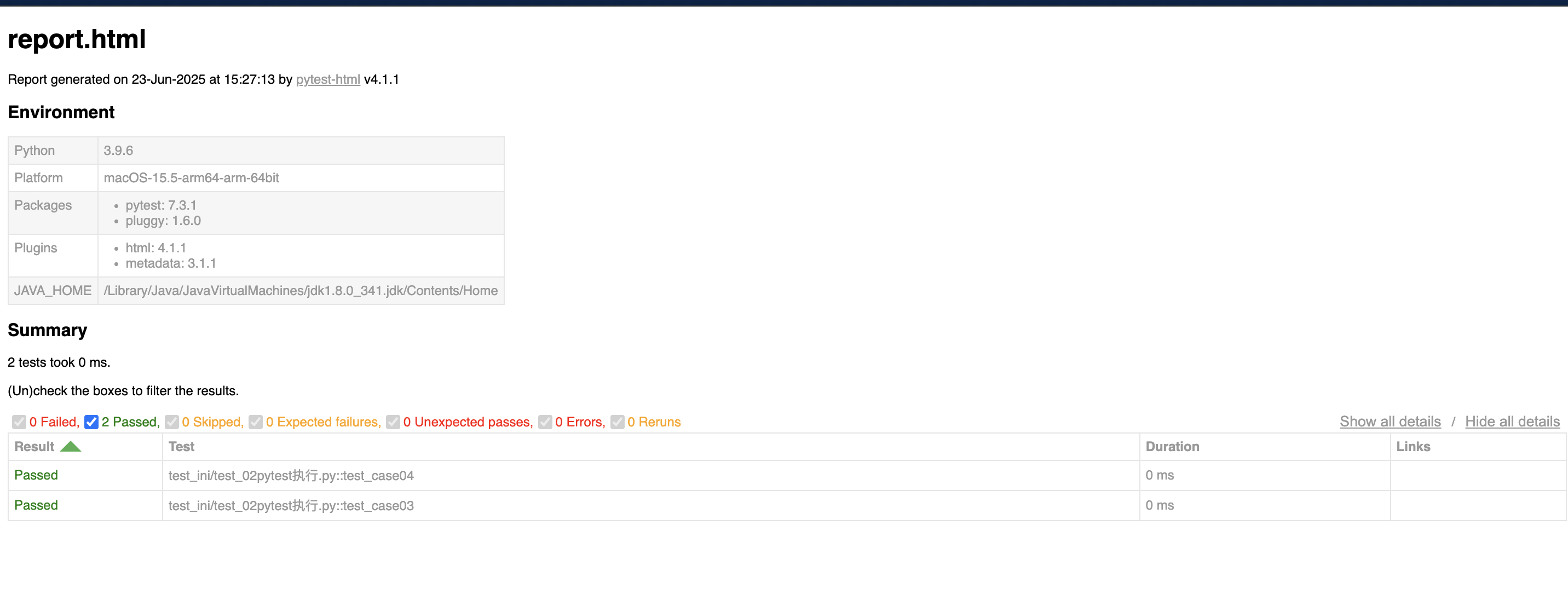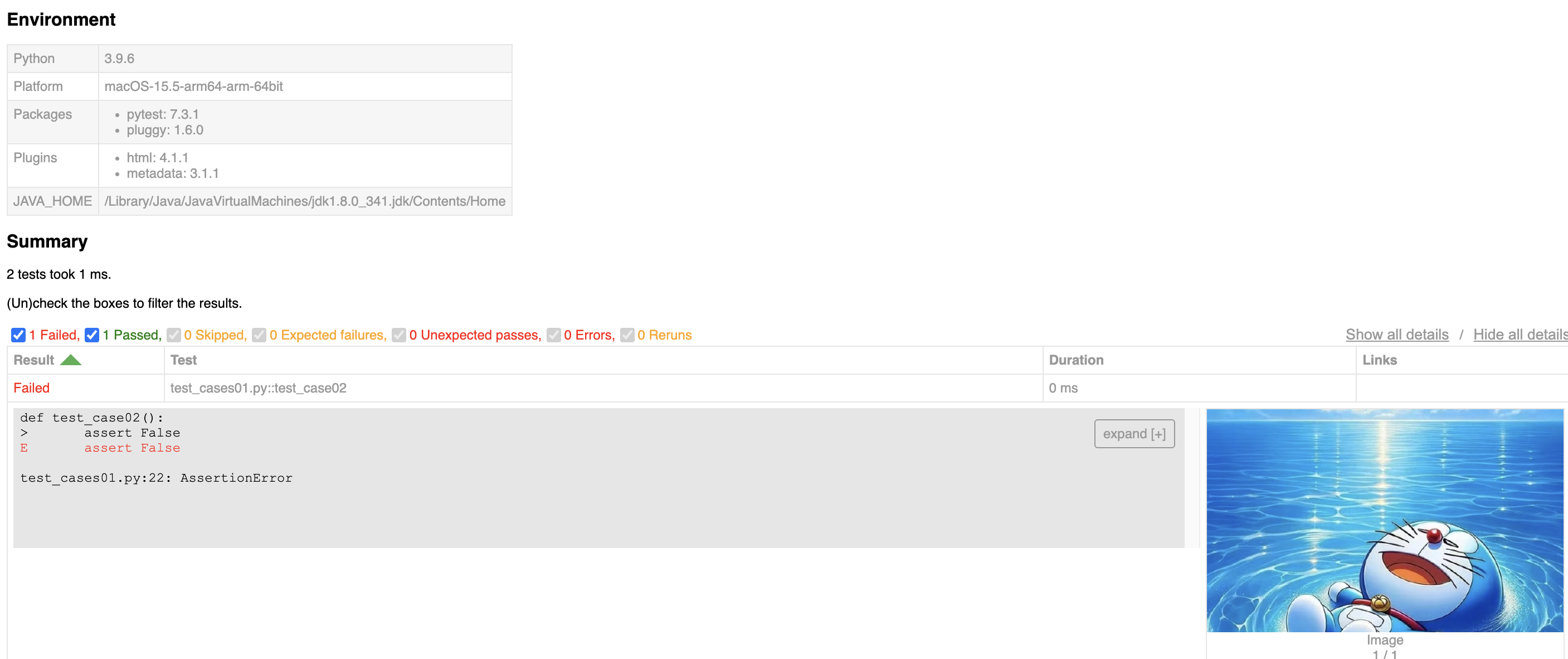Pytest
Pytest介绍
pytest 是 Python 中最流行的单元测试框架之一,相比于自带的 unittest:
-
语法更简洁,使用更灵活
-
自动发现测试用例
-
丰富的插件生态
简单的组成结构
import pytest def test_case01(): # 测试用例1 print("我是用例主体") def test_case02(): # 测试用例2 print("我这里可以写任何测试用例") if __name__ == "__main__": pytest.main(['-s']) # 执行测试用例
Pytest的安装和执行
使用pip安装
pip3 install pytest==7.3.1 # 使用pip安装pytest7.3.1版本 pytest --version # 校验pytest是否成功安装
命令行中执行
# 执行11pytest路径下所有的测试文件中所有测试用例 pytest 11pytest # 执行test_01pytest执行.py文件中所有的测试用例 pytest 11pytest/test_01pytest执行.py # 执行test_01pytest执行.py里面test_case01这条测试用例 pytest 11pytest/test_01pytest执行.py::test_case01
参数说明
官方文档参数说明:https://docs.pytest.org/en/stable/how-to/usage.html
-s 开启终端交互
作用是可以让打印的内容输出显示在终端,或者可以在终端中与用例中的输入操作进行交互
pytest -s 11pytest
-v 输出更详细的信息
包括测试用例的详细结果和其他相关信息,例如测试用例所在的模块,文件路径等
pytest -v 11pytest
-s -v 可以合并到一起写:-sv 或 -vs
pytest -sv 11pytest
-k 筛选用例(模糊匹配)
仅运行匹配的测试用例。指定一个字符串表达式,pytest将根据表达式匹配测试用例的名称来执行相应的测试。-k筛选的不止函数层级,文件中包含同样的关键字也会匹配到。
pytest -sv -k "03" 11pytest # 仅执行11pytest路径下包含03的测试用例
Python脚本中运行
if __name__ == "__main__": pytest.main(['test_01.py', '-vs', '-k', '02'])
if __name__ == "__main__": pytest.main(['test_01.py::Test01::test001', '-vs'])
命名规则
测试文件
以test_*.py开头,或"_test.py"结尾。比如:test_login.py
测试类:
以Test开头,利润class TestLogin:
测试函数:
以test_开头,这样pytest会自动识别并执行这些函数作为测试用例。
例如:def test_login_success():或def test_add_product_to_cart()
使用下划线分隔单词
函数名见名知意,例如:test_login_success()测试登录成功的场景
前置和后置
传统的setup和teardown系列(不推荐使用)不如fixture灵活
import pytest # 模块中的前后置,不能写在测试类中 def setup_module(): print("模块级别的前置操作") def teardown_module(): print("模块级别的后置操作") def setup_function(): print("方法级别的前置操作_function") def teardown_method(): print("方法级别的后置操作_function") class Test_login: @classmethod # 类级别需要加classmethod装饰器 def setup_class(self): print("类级别的前置操作") @classmethod def teardown_class(cls): print("类级别的后置操作") # 类中的方法前后置为_method,如果不在类中可以写_function def setup_method(self): print("方法级别的前置操作") def teardown_method(self): print("方法级别的后置操作") def test_case01(self): print("test_case01") if __name__ == '__main__': pytest.main("./test_前置后置.py", "-vs") 执行结果: 模块级别的前置操作 类级别的前置操作 方法级别的前置操作 PASSED [100%]test_case01 方法级别的后置操作 类级别的后置操作 模块级别的后置操作
import pytest def setup_module(): print("模块级别的前置操作") def teardown_module(): print("模块级别的后置操作") def setup_function(): # 写在类外面的方法级别的前后置以:_function结尾 print("方法级别的前置操作_function") def teardown_function(): print("方法级别的后置操作_function") def test_case01(): print("test_case01") if __name__ == '__main__': pytest.main("./test_前置后置.py", "-vs") # 执行结果 模块级别的前置操作 方法级别的前置操作_function PASSED [100%]test_case01 方法级别的后置操作_function 模块级别的后置操作
标签的使用
使用标签可以对测试用例进行分类和分组,通过为标签,选择性的执行特定标签的测试用例,从而方便的控制测试的范围和目标。
下面对标签功能进行演示和说明
1.定义标签的代码
import pytest @pytest.mark.smoke # 使用pytest.mark定义标签,smoke为自定义的标签名,可以是任何 def test_login(): assert True @pytest.mark.regression # 定义一个名为regression的标签 def test_regression(): assert True @pytest.mark.smoke def test_add_to_cart(): assert True @pytest.mark.regression def test_checkout(): assert True
2.在项目目录中创建一个名为pytest.ini的配置文件,名字固定,不可自定义
配置文件中的内容。如果配置文件不生效或者未声明标签,会在执行时报警告
[pytest] markers = # 所有的标签在markers下声明 smoke:Run smoke test # 对smoke标签进行说明 regression:Run regression tests
3.命令行中执行下面的命令
pytest 11pytest/test_label.py -m smoke -vs # -m smoke表示仅执行标签为smoke的测试用例
执行结果仅运行smoke标签标记的测试用例
还可以这样用
pytest -m "smoke or regression" ./11pytest/test_label.py
conftest
conftest.py是一个特殊的文件,管理测试用例中需要通用的数据传递。
conftest的存放位置:
project/
│
├── conftest.py <-- 写公共的 fixture
├── test_login.py <-- 不需要导入 fixture
├── test_order.py
conftest的作用范围:
如果放一个顶级的conftest用于全局fixture
每个子测试模块也可以放一个conftest.py为该模块生效
@pytest.fixture 装饰器的常用参数
scope=
"function":(默认值),每个测试函数都会调用一次。通过yield控制前置和后置。yield前为前置执行的代码,yield后为后置要执行的代码,此规则不仅适用于function,其他级别均可以使用yield控制前后置
"class":每个测试类都会调用一次
"module":每个测试模块都会调用一次
"session":每个测试会话都会调用一次
# 代码演示: import pytest @pytest.fixture(scope="function") def setup_teardown(): print("=== 前置操作 ===") yield # yield 前是前置逻辑,后是后置逻辑 print("=== 后置操作 ===") def test_case1(setup_teardown): print("执行测试用例 1") """ 执行结果: 11pytest/config_test/test_conftest.py::test_case1 === 前置操作 === 执行测试用例 1 PASSED=== 后置操作 === """
params:给 fixture 提供多个参数值,每个值都会触发一次测试执行
@pytest.fixture(params=["admin", "user", "guest"]) def role(request): return request.param def test_user(role): print(f"当前用户是:{role}") assert role in ["admin", "user", "guest"] 执行结果: 11pytest/config_test/test_conftest.py::test_user[admin] 当前用户是:admin PASSED 11pytest/config_test/test_conftest.py::test_user[user] 当前用户是:user PASSED 11pytest/config_test/test_conftest.py::test_user[guest] 当前用户是:guest PASSED
autouse:自动使用fixture,无需在测试函数中显式声明使用该fixture。True和False
@pytest.fixture(autouse=True) # autouse=True表示每个测试函数执行前都会自动执行这个fixture。即使不在测试函数中引用。 def always_run(): print("这个 fixture 每个测试都会自动运行") def test_case1(): # 这里不用引用always_run也会自动执行 print("执行测试用例 1") def test_case2(): print("执行测试用例 2") """ 执行结果 11pytest/config_test/test_conftest.py::test_case1 这个 fixture 每个测试都会自动运行 执行测试用例 1 PASSED 11pytest/config_test/test_conftest.py::test_case2 这个 fixture 每个测试都会自动运行 执行测试用例 2 PASSED """
name:为fixture自定义名称
@pytest.fixture(name="login_token") def login_fixture(): return "这是login_fixture" def test_something(login_token): assert login_token == "这是login_fixture" """ 执行结果: 11pytest/config_test/test_conftest.py::test_something PASSED """
pytest.ini配置文件的使用
一、pytest.ini介绍
避免每次运行都手动输入一堆命令参数,让项目更规范
pytest.ini 是 pytest 的配置文件,用于集中定义项目中的:
-
启动参数(比如默认加上
-v -s) -
标记(marks)声明
-
测试路径规则
-
忽略的警告
-
插件配置(如 pytest-html、pytest-cov)
二、pytest.ini的推荐存放路径:项目的根目录
my_project/ ├── pytest.ini ├── tests/ │ ├── test_xxx.py ├── src/ │ └── ...
[pytest]
;addopts:设置默认运行参数(每次运行 pytest 时都生效)
addopts = -v -s --html=report.html --tb=short
;testspath:指定测试用例所在的目录(默认当前目录)
testspath = test_ini
;python_files:指定测试文件的匹配规则,默认是test_*.py
python_files = test_*.py *_test.py
;python_classes:指定测试类的匹配规则,默认是Test*
python_classes = Test*
;python_functions:指定测试函数的匹配规则
python_functions = test_*
;markers:声明项目中用到的mark标签,必须在这里声明才能在使用,否则会报警告
markers =
smoke:冒烟测试用例
login:登录模块测试用例
pytest- html生成测试报告
基础数据报告
安装pytest-html
pip install pytest-html
生成测试报告
pytest --html=./report/report.html
执行结果


放到pytest.ini中
--self-contained-html表示,将 HTML 报告的所有资源(如 CSS、JS)内联到单个文件中,方便分享。
addopts = -v -s --html=report/report.html --self-contained-html
异常时添加图片
import pytest from pytest_html import extras @pytest.hookimpl(hookwrapper=True) # 写死的 def pytest_runtest_makereport(item, call): # 写死的 def image_to_base64(image_path): import base64 """这个函数是将图片转化为base64数据""" with open(image_path, "rb") as image_file: encoded_string = base64.b64encode(image_file.read()) return encoded_string.decode('utf-8') outcome = yield report = outcome.get_result() extra = getattr(report, "extra", []) if report.when == "call": # 过滤 前置,和后置,只保留运行中的状态 print("用例执行结果:", report.outcome) # 用例执行结果 if report.outcome != "passed": """失败截图数据""" image_path = "test_image.jpg" # 这里你可以换成你的图片路径 base64_data = image_to_base64(image_path) extra.append(extras.image(base64_data)) report.extra = extra # 替换数据中的 extra 对象

pytest数据驱动
说明:使用不同的测试数据执行相同的测试用例。可以减少测试代码冗余。
第一种数据驱动方案
@pytest.mark.parametrize
import pytest @pytest.mark.parametrize( "input1, input2, expected", [ (1, 2, 3), (5, 5, 10), (10, -2, 8) ] ) def test_case(input1, input2, expected): assert input1 + input2 == expected
执行结果
test_数据驱动.py::test_case[1-2-3] PASSED test_数据驱动.py::test_case[5-5-10] PASSED test_数据驱动.py::test_case[10--2-8] PASSED
第二种数据驱动方案
# conftest.py import pytest @pytest.fixture(params=[ (1, 2, 3), (5, 5, 10), (10, -2, 8)], name="test_data" ) def data(request): return request.param
# test_case.py def test_addition(test_data): assert test_data[0] + test_data[1] == test_data[2]
# 执行结果 test_case.py::test_addition[test_data0] PASSED test_case.py::test_addition[test_data1] PASSED test_case.py::test_addition[test_data2] PASSED





 浙公网安备 33010602011771号
浙公网安备 33010602011771号